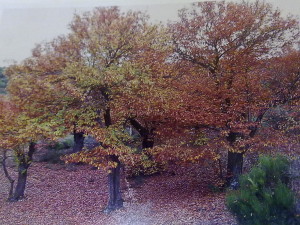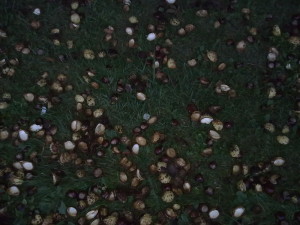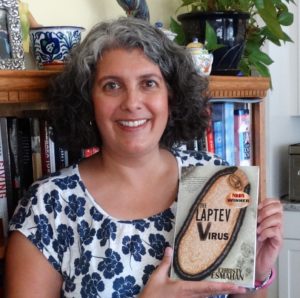
Chestnut trees with their plentiful fruit on the ground–amazing, isn’t it! Thanks so much to my friends Luis Mariano and Marisa for the photo!
Before I went to Spain, chestnuts were something from a Christmas carol—they roasted on an open fire or pop-pop-popped while people sat singing around a fireplace. The word made me feel nostalgic, but in a vapid way as there were no memories of ever having eaten one before, or even seen one in a fireplace. All of this changed in Spain, when on the way home from El Barrio Húmedo one night, we stopped to buy castañas–chestnuts.
It was a frosty night, one of those where I was stamping my feet to wake up my frozen toes inside my boots and constantly rubbing my gloved hands together to try to get some feeling back into my frigid fingers. Stars twinkled above the darkened city and the rich smell of wood burning was in the air when we stopped by this little stand where a wizened woman, dressed all in black, sat on a little wooden bench by a barrel. The barrel was filled with charcoal that glowed yellow and orange and little embers, tiny sparks, escaped every now and then into the air and shone briefly in the dark night before extinguishing themselves, like tiny errant falling stars. A grill had been placed over the top of the barrel, and on it were the castañas, little brown blobs that emanated a wholesome smell. One of my friends asked for 300 pesetas worth of nuts, and the old woman took a few sheets of newspaper from a stack on the cobbled stones of the road and expertly shaped them into a cone which she held in her left hand while she used a pair of battered tongs to gingerly remove the nuts from the fire and toss them into the cone. As we headed back to the dorm, the nuts were passed around and soon I had a group of excited women showing me the best way to peel one: how to hold it gingerly so as not to get burned, and how to remove both its thin shell and the dark skin around the light-colored meat. Soft, sweet and deliciously warm, the chestnut tasted like a Christmas carol!
According to Wikipedia, it turns out that castañas were used as a food staple for thousands of years, and until the potato was discovered in the Americas, lots of people throughout Europe used chestnuts as their main source of carbohydrates. I found a lovely blog called “My Kitchen in Spain” by Janet Mendel which gives a mouthwatering recipe from Galicia for cooking ribs and chestnuts. With all the health benefits of chestnuts—they are less caloric than walnuts and pecans, high in fiber, low on carbs and even good for your brain, according to the website, Healthy Eating–it’s no wonder they are so popular.
Today there are entire villages whose main commerce is chestnuts, exporting not only the fresh nuts to the rest of Spain and much of Europe, but also making chestnut flour, pickling chestnuts, chestnut jam, honeyed chestnut candies and much more. On one website called “Foods from Spain” I found that Spain exports more than 30 different products made from chestnuts. According to an article entitled “Spain’s credit squeeze thwarts small companies’ export plans”, one company alone exported more than $1.3 million worth of chestnut delicacies just last year, a thriving business (though unfortunately, even companies doing this well are having trouble getting loans from banks as restrictions are so tough, which is a terrible shame—I wonder if Bill Gates would be interested in helping them out too?)
The family of some of my friends from León own land where there are lots of castaña trees, and every year she heads north for several weeks to collect the bounteous crop which brings in enough money to sustain the family for the rest of the year. She and her husband kindly provided me with the pictures in this blog today.
So now that it’s getting chilly outside and the carols will soon be playing, why not pick up a bag of chestnuts in your supermarket, and try roasting them in your oven (but be sure to cut a small slice into the skin before you do so you don’t have one pop!) And if you find yourself in Spain in November, I’d recommend that you make plans to head out to the hills and mountains, especially in the north, with a good pair of water-proof boots, and have fun collecting this plentiful fruit.
If you enjoyed this blog post, you might also like my series of novels, Bueno, Sinco and Brujas, which takes place in Santander, Spain.




5 comments
Skip to comment form
Nice to know that you can order them online. I love them and I’ve tried them from different places. The best are from Central Market. An employee told me they get a new sack every week from Italy 😉
Author
Wow, Araceli, I didn’t know that! 🙂 That’s great!
Thank you, Christy, for linking to my chestnut story in your blog. Glad you are enjoying chestnuts in Spain.
Author
My pleasure, Janet! 😉
Author
After writing this post, I went on-line to order some chestnuts, and they have been wonderful–very fresh and tasty. I therefore heartily recommend this site: http://www.chestnutgrowersinc.com/